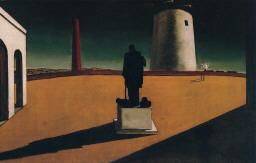Paris is celebrating Giorgio De Chirico's art and his links with the city's intellectual and artistic elite with a major retrospective opening on Friday at the Museum of Modern Art.
The show gathers 160 works - paintings, sculptures, drawings and etchings - which trace his career from 1909 to 1975 and explore how he interacted with his artistic forerunners and contemporaries.
De Chirico. The Factory of Dreams', comes to Paris after a hit run at Rome's National Gallery of Modern and Contemporary Art to mark the 30 years since the artist's death in 1978.
De Chirico was born in Greece to Italian parents and he studied art in Athens before moving to Germany in 1906 to enter Munich's Academy of Fine Arts.
During his three-year stay he was also influenced by his reading of the German philosophers Friedrich Nietzsche and Arthur Schopenhauer.
He returned to Italy in 1909, spending time in Milan, Florence and Turin and painting the first of his 'metaphysical' paintings before moving to Paris in 1911 to join his brother Andrea.
There he met the poet Guillaime Apollinaire - who first coined the term 'peinture metaphysique' to describe his work - and was introduced to Picasso, Derain, Braque, Picabia and Paul Guillaime, the first art dealer to sell his works.
The Paris show spotlights his influential metaphysical paintings - mostly produced between 1909 and 1919 - but also features a large selection of lesser-known works he created after 1920 when he returned to traditional styles and iconography, often parodying works by masters like Raphael, Titian and Rubens.
The exhibit, which is the first in Paris since the Centre Pompidou celebrated the artist in 1983, features many works from his personal collection which are kept by the Giorgio De Chirico foundation.
The artist was fascinated by the ancient world, archeology and neo-classicism and a section of the show explores this theme.
Another section features a collection of works by De Chirico painted in the style of great masters from previous centuries.
'Great Painting' takes an article he wrote in autumn 1919 as its springboard, entitled 'The Return of Craftsmanship'.
Published in a leading Italian art journal of the day, Valori Plastici, the article advocated a return to traditional methods and marked a turning point in his own work, away from the metaphysical movement he helped found.
By the late 1930s, De Chirico had adopted a neo-baroque style, which he partly attributed to Rubens. His work from this period never gained the same critical success as his earlier metaphysical works.
However, the artist thought these were among his best pieces and kept them in his own collection, parts of which have been loaned out by the De Chirico Foundation.
The final section, Neometaphysics, features a selection of metaphysical works De Chirico painted in his later years, many of which backdated ''self-forgeries''.
This was partly a jab at critics hostile to his later style and partly to profit from his early successes. However, in his final years he even denounced some of these works as forgeries by other artists.
De Chirico (1888-1978) had an enormous impact on 20th-century painting.
Officially founded in 1917 with Carlo Carra', the metaphysical movement influenced artists from Joan Miro to Willem De Kooning, although it lasted a brief decade.
De Chirico's trademark works feature oddly haunting neo-classical buildings and statues towering above midget figures and empty streets.
A number of De Chirico paintings anticipate Surrealism, with their overt air of menace and troubling, mysterious symbols that leave the viewer with more questions than answers.
By painting people not as they appear but as mannequins or semi-abstract symbols, the metaphysical painters aimed to ''reveal the reality underneath''.
The show runs at the Musee d'Art moderne de la Ville de Paris until May 24.









